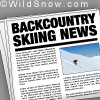Washington state has incredible skiing, and is blessed with some great ski terrain. However, much of our terrain is quite inaccessible. In comparison to many other mountain regions, we have relatively few snow recreation access points during a normal winter. With few exceptions, our access points are mostly restricted to major highway passes and roads that lead to ski areas. Most summer access roads are not plowed to any significant degree in winter, and many that are naturally snow-free are gated well below snowline, often into late spring.
(This post sponsored by our publishing partner Cripple Creek Backcountry.)
We do have a relatively large population in Washington (at least compared to places such as Montana or Wyoming), with large urban centers near the mountains. However, compared to some of the other mountainous regions, we currently have a relatively small population of skiers and other winter recreationalists. (I did research that.) Even with that being the case, our lack of access results in increasingly crowded backcountry skiing zones where users end up being concentrated. I’ve certainly noticed this in the time that I have lived here, and many others have as well, especially those that have been here longer than I.
Thankfully, in Washington we have no shortage of ski terrain, only a shortage of accessible ski terrain. I believe we could change this by opening up a few more areas to winter human-powered access. Throughout the state, there are quite a few candidates. In my opinion, even creating or improving one more winter trailhead would dramatically increase our options.
I’ve idly had these thoughts for years, as have many others, I’m sure. However, a group of backcountry users are now doing something about it. Enter the Cascade Backcountry Alliance. (CBA) Washington’s very own winter recreation access advocacy group. The group, started this year, has interesting goals.
The mission:
The Cascade Backcountry Alliance works to ensure winter access for backcountry recreational users across Washington state. CBA seeks to foster a community voice and mountain culture for skiers, splitboarders, and other snow travelers in order to preserve access to trailheads, distribute the impact of different user groups, and preserve the backcountry experience of freedom and exploration.
The CBA is just getting started, and has some lofty goals. To begin, they are focusing on improving the parking options for backcountry travelers on Snoqualmie Pass (a much more accessible goal than convincing the powers that be to snowplow an entire backcountry road).
Here’s a condensed list of other possible goals that are published on the CBA website (see their website for detail):
Mt. Baker region:
— Try to funnel uphill traffic into safer travel routes via signs and education.
— Improve parking and access along the 542 corridor. Current priorities are the Twin Lakes/Winchester Mountain Lookout road and the Skyline divide road.North Cascades National Park region:
— Ensuring gates are not kept locked for arbitrary reasons when access is reasonable.
— Advocate for expanded plowing operations on key access roads such as the Cascade River Road.
— Provide better conditions reports on existing roads and snowmobile access points.Stevens pass region:
— Ally ourselves with the resort as much as possible as they look for more parking solutions.
— Work with DOT to ensure cars can park without being towed at Jim Hill, Rock Mountain, and other backcountry trailheads. Clarify safe parking locations.
— Advocate for expanded plowing at as many trailheads as possible.
— Encourage the expansion of ride-sharing options to this area.Snoqualmie pass region:
— Additional parking at the PCT trailhead.
— A designated dog-walking area in the valley.
— Continued grooming of a specific resort exit/downhill traffic lane.
— A marked and maintained snowshoe trail to Source Lake for all foot traffic, or the popularization of the summer trail route for snowshoers.
— A skintrack or uptrack route from lot 4, hopefully with limited snowshoe trafficMt. Rainier National Park region:
— Establish the importance of winter access to the park.
— Ensure that conflict between rangers and backcountry users is minimized, and continue to advocate for the plowing and maintenance of the road to Paradise.
— Work to guarantee that gates are not kept locked for arbitrary reasons when access is reasonable.
— Help the park communicate clearly about what roads and facilities are open.
This is an exhaustive list with tons of grand ideas — some controversial — although in my opinion any of these would certainly improve winter recreation in Washington. Readers, your opinions?
Louie Dawson earned his Bachelor Degree in Industrial Design from Western Washington University in 2014. When he’s not skiing Mount Baker or somewhere equally as snowy, he’s thinking about new products to make ski mountaineering more fun and safe.

